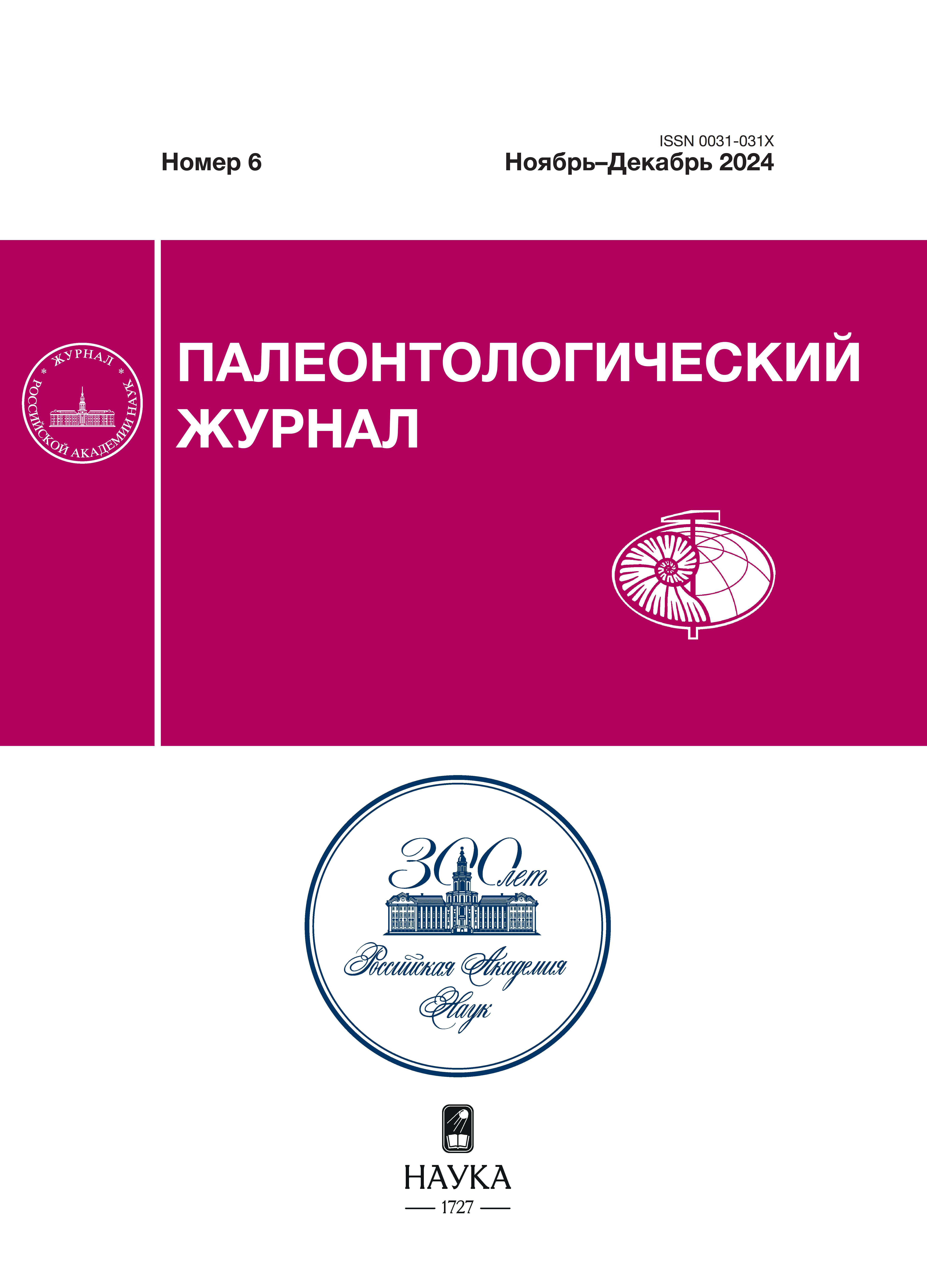New species of Otozamites braun (Bennettitales) with preserved anatomical structure from the middle jurassic of Kursk region, Russia
- Authors: Bazhenova N.V.1
-
Affiliations:
- Borissiak Paleontological Institute, Russian Academy of Sciences
- Issue: No 6 (2024)
- Pages: 125-139
- Section: Articles
- URL: https://ruspoj.com/0031-031X/article/view/677971
- DOI: https://doi.org/10.31857/S0031031X24060114
- EDN: https://elibrary.ru/QIENNM
- ID: 677971
Cite item
Abstract
The new bennettitalean species Otozamites meyenii sp. nov. is described from the Middle Jurassic deposits of the Mikhailovskii Rudnik open mine (Kursk Region). The new species is characterized by long finger-like papillae on the covering cells of the pinnae lower epidermis. The rachis vascular system of the new species possesses structure, characteristic of leaves of other Bennettitales: a ring, formed by two U-shaped rows of collateral vascular bundles with xylem faced toward interior. Unlike the Lower Cretaceous O. kerae Ohana et Kimura, possessing well defined bundles, the new species has indistinct boundaries between bundles. Our data also point on the presence in representatives of the genus Otozamites Braun of tracheids, characteristic of several angiosperms, whereas the presence of vessels in the vascular system of Otozamites leaves has not been confirmed.
Keywords
Full Text
About the authors
N. V. Bazhenova
Borissiak Paleontological Institute, Russian Academy of Sciences
Author for correspondence.
Email: gordynat@mail.ru
Russian Federation, Moscow
References
- Горденко Н.В., Броушкин А.В. Семенные органы Trisquamales ordo nov. (Gymnospermae) из средней юры Курской области, европейская часть России // Палеонтол. журн. 2018. № 1. С. 86–104.
- Красилов В.А. Происхождение и ранняя эволюция цветковых растений. М.: Наука, 1989. 263 с.
- Barale G. La paléoflore Jurassique du Jura Français: étude systématique, aspects stratigraphiques et paléoécologiques. Villeurbanne, 198l. 467 p. (Docum. Lab. Géol. Lyon. 198l. № 81).
- Barbacka M., Pálfy J., Smith P.L. Hettangian (Early Jurassic) plant fossils from Puale Bay // Rev. Palaeobot. Palynol. 2006. V. 142. № 1–2. P. 33–46.
- Barnard P.D., Miller J. Flora of the Shemshak Formation (Elburs, Iran), Part 3: Middle Jurassic (Dogger) plants from Katumbargah, Vasek Gah Imam Manak // Palaeontogr. Abt. B. 1976. Bd 155. Lief. 1–4. P. 31–117.
- Bierhorst D.V. Morphology of Vascular Plants. N.-Y.: Macmillan, 1971. 560 p.
- Bomfleur B., Pott Ch., Kerp H. Plant assemblages from the Shafer Peak Formation (Lower Jurassic), north Victoria Land, Transantarctic Mountains // Antarctic Sci. 2011. V. 23. № 2. Р. 188–208.
- Bose M.N., Kasat M.L. The genus Ptilophyllum in India // Palaeobotanist. 1972. V. 19. № 2. P. 115–145.
- Bose M.N., Zeba-Bano. The genus Dictyozamites Oldham from India // Palaeobotanist. 1978. V. 25. P. 79–99.
- Dower B.L., Bateman R.M., Stevenson D.W. Systematics, ontogeny, and phylogenetic implications of exceptional anatomically preserved cycadophyte leaves from the Middle Jurassic of Bearreraig Bay, Skye, Northwest Scotland // The Botan. Rev. 2004. V. 70. № 2. P. 105–120.
- Gordenko N.V. Middle Jurassic flora of the Peski locality (Moscow Region): systematics, paleoecology, and phytogeography // Paleontol. J. 2008. V. 42. № 12. P. 1285–1382.
- Gordenko N.V., Broushkin A.V. A new bennettitalean genus from the Middle Jurassic of the Mikhailovskii Rudnik locality (Kursk Region, Russia) // Paleontol. J. 2010. V. 44. № 10. P. 1308–1320.
- Gupta K.M., Sharma B.D. Investigations on the Jurassic flora of the Rajmahal hills, India: 2 – On a new species of Ptilophyllum, P. sahnii from Amarjola in Amarapara region // J. Palaeontol. Soc. India. 1968. V. 11. № 5–9. P. 21–28.
- Harris Т.М. The Yorkshire Jurassic Flora, III. L.: Brit. Mus. (Natur. Hist.), 1969. 186 р.
- Krassilov V.A. Early Cretaceous flora of Mongolia // Palaeontogr. Abt. B. 1982. Bd 181. Lief. 1–3. P. 1–43.
- Ohana T., Kimura T. Permineralized Otozamites leaves (Bennettitales) from the Upper Cretaceous of Hokkaido, Japan // Trans. Proc. Palaeontol. Soc. Japan. 1991. V. 164. P. 944–963.
- Rao A.R., Achuthan V. Further contribution to our knowledge of the anatomy of Ptilophyllum // Palaebotanist. 1967. V. 16. № 3. P. 249–257.
- Ray M.M., Rothwell G.W., Stockey R.A. Anatomically preserved Early Cretaceous Bennettitalean leaves: Nilssoniopteris corrugata n. sp. from Vancouver Island, Canada // J. Paleontol. 2014. V. 88. № 5. P. 1085–1093.
- Sharma S.D. Investigation on the Jurassic flora of Rajmahal Hills, India. 3. A review of the genus Ptilophyllum of Morris, with description of two new species from Amarjola in the Rajmahal Hills // Palaeontogr. Abt. B. 1967. Bd 120. Lief. 5–6. P. 139–150.
- Schweitzer H.-J., Kirchner M. Die rhäto-jurassischen Floren des Iran und Afghanistans: 13. Cycadophyta III. Bennettitales // Palaeontogr. Abt. B. 2003. Bd 264. Lief. 1–6. S. 1–166.
- Tidwell W.D., Kim J.H., Kimura T. Mid-Mesozoic leaves from near Ida Bay, southern Tasmania, Australia // Pap. Proc. R. Soc. Tasman. 1987. V. 121. P. 159–170.
- Vishnu-Mittre. Studies on the fossil flora of Nipania, Rajmahal Series, India – Bennettitales // Palaeobotanist. 1956. V. 5. № 2. P. 95–99.
- Yamada T. Structurally preserved Zamites bayeri Kvaček from the Coniacian Kashima Formation (Yezo Group) of Hokkaido, Japan // Cret. Res. 2009. V. 30. № 5. P. 1301–1306.
- Yamada T., Legrand J., Nishida H. Structurally preserved Nilssoniopteris from the Arida Formation (Barremian, Lower Cretaceous) of southwest Japan // Rev. Palaeobot. Palynol. 2009. V. 156. № 3–4. P. 410–417.
Supplementary files

















